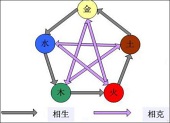| The Five Elements Theory The Five Elements, also called “Wu Xing”, here refer to wood, fire, earth, metal, and water. According to the Chinese medicine, these Five Elements are the basic elements of the material world and represent the processes that are fundamental to the cycles of nature. Health is a harmonious balance of all the elements.
| 
|
The wood element represents the liver (Yin), and the gallbladder (Yang). The liver stores blood and the gallbladder is responsible for storing and excreting bile. Anger is the emotion that creates imbalance within the liver, while indecisiveness is relative to the gallbladder. People who have strong energy of the Wood element have a clear vision and goals, and know how to bring them into being. They are good at planning and making decisions. They can be forceful in disagreements and can strongly argue their opinions. Their piercing, penetrating eyes may attract you, but avoid their wrath. The element of Fire is considered to be hot and ascending. It affects the complementary organ processes of the pericardium and the triple warmer, which is representative of the whole body. Overindulgence is the emotion which creates imbalance within this element. People with strong Fire energy may be quite charismatic. They have a strong ability of commanding others to action. They may love talking and socializing. The earth element relates to the stomach (Yang) and the spleen (Yin). The stomach begins the process of digestive breakdown, while the spleen transforms and transports the energy from food and drink throughout the body. Pensiveness is the emotion which creates imbalance within this element. Someone with well developed Earth energy is a well grounded, nurturing, compassionate person. Earth people like to bring others together and make good mediators or peacemakers and reliable friends. They often enjoy both preparing food and eating. You may be attracted by their generous mouth and full, sensuous lips. The element of Metal plays a role as a conductor which includes the lungs (Yin) and the large intestine (Yang). The lungs move vital energy throughout the body, while the large intestine is responsible for receiving and discharging waste. Sadness, or grieving is the emotion which creates imbalance within this element. A person with well balanced Metal energy is well organized, self disciplined, and conscientious. They like structure in their life. They are most comfortable in situations when they know the rules and can succeed by following them. Water is wet, descending, and flowing. The Water element represents the urinary bladder (Yang), and the kidney (Yin). The bladder receives, stores, and excretes urine. Water metabolism dissipates fluids throughout the body, moistening it, and then accumulating in the kidneys. The kidneys serve as the root of Yin and Yang for the entire body. Fear and paranoia are the emotions which create imbalance within this element. The Water energy is a strong generative force centered in the lower stomach. |